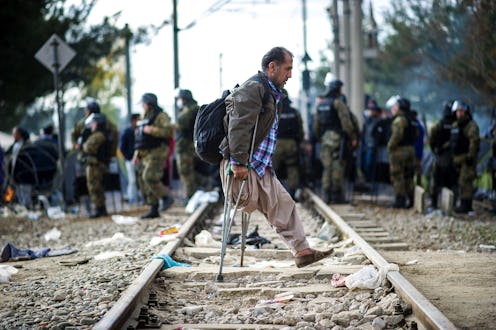News
Canada's Refugee Plan Has A Major Catch
On Monday, Nov. 23, Canada announced a comprehensive and fast-acting Syrian refugee plan with one major exception — it will not allow single men into the country, opting instead to bring in lone women, children, and families only. Many of these refugees, men included, are seeking safety from the Islamic State of Iraq and Syria (ISIS). With further details to be publicized later this week, the government stated that these men — now considered a heightened security risk in the wake of the terrorist attacks in Paris — will ultimately be turned away at the border's doors. But does this plan offer the best and safest solution, or instead feed into the fearful idea of what a terrorist is "supposed to look like" and further hurt a group desperately seeking asylum?
Details in Canada's plan reveals that they will attempt to act swiftly, and in many ways, boldly — they hope to bring in as many as 25,000 refugees by the end of 2015, equaling out to 900 people per day and 15,000 more than the United States has proposed to take in. In keeping up with this program over the course of 6 years, the country will eventually spend an estimated $1.2 billion Canadian dollars ($900 million). Nearly 70 percent of that will be spent during the first year, with a large percentage of the budget going toward the initial cost of airlifting refugees into Canada.
However, that financial boldness comes at the price of excluding men from opportunities for safety. Canada's adherence of their standard to the common profile of a terrorist — single men thought likely to be swept up by terror groups — inherently limits its humanitarian efforts on the basis of gender. This narrative, trumped up on fear and exclusion, is dangerous. The plan essentially suggests that only men, despite being the victims of terrorism themselves, can pose a terroristic threat.
Statistics say otherwise. For instance, 10 percent of ISIS' recruits from Europe, Australia, and North America are women. The number of women joining ISIS overall is likewise growing. In this same line of thought, should women not also be barred from entering Canada for fear of increased threat?
Thomas Mulcair, Canada's leader of the New Democratic Party, had similar apprehension over the plan's limitations:
Will a young man who lost both parents be excluded from the refugee program? Will a gay man who is escaping persecution be excluded? Will a widower who is fleeing Daesh after having seen his family killed be excluded?
These men are just as likely to have experienced the same horrors as any of those being granted access into Canada have. They too, just like the women, families, and children, are victims of ISIS' attacks. The program's inclination to bow to fear over who it deems more likely to be a terrorist does the refugees no good, and may even bolster ISIS.
The argument that the men's exclusion is to the benefit of increased, overall security is an abject one. Though ISIS and even small-time gangs are known for attracting lone, disenfranchised men, this same fact is why they in particular must be granted security. These refugees are the same most likely to be targeted — and often times coerced — by terror groups.
To deny them safety on the rare hypothetical of what they may do versus what harm will undoubtedly come to them if forced to stay in Syria is to likewise weigh an imagined threat versus a real one.
